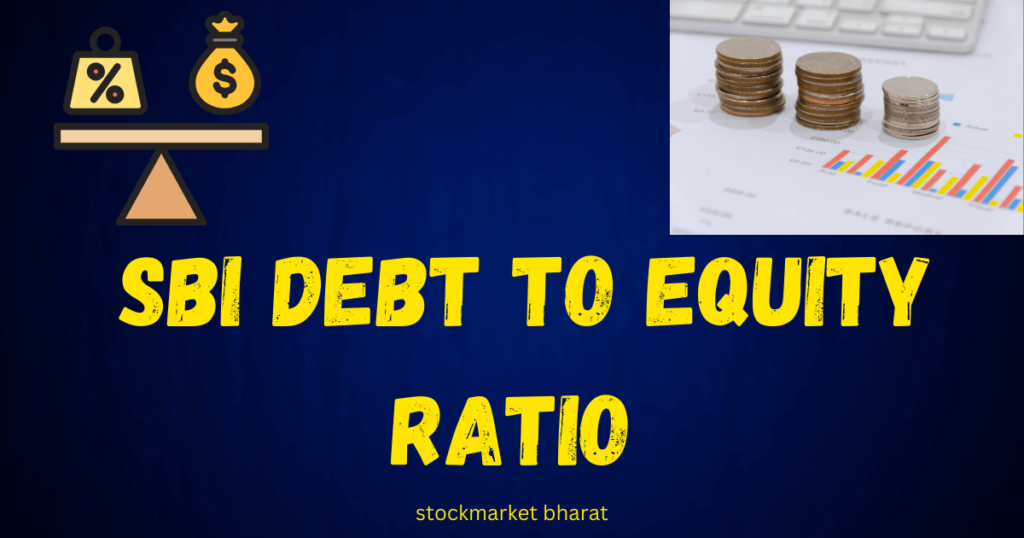SBI DEBT TO EQUITY RATIO
Understanding SBI’s Debt to Equity Ratio: A Key Financial Indicator
When evaluating the financial stability of a bank, one of the most important metrics analysts and investors consider is the debt to equity ratio. For State Bank of India (SBI), India’s largest public sector bank, this ratio provides valuable insights into its financial health, risk profile, and capital structure. In this blog, we will explore what the debt to equity ratio signifies, SBI’s financial standing, and how it impacts investors.

What is the Debt to Equity Ratio?
The debt to equity (D/E) ratio is a crucial financial metric that measures the proportion of a company’s total debt to its shareholder equity. The formula for calculating the ratio is:
Debt to Equity Ratio=Total DebtTotal Shareholder Equity\text{Debt to Equity Ratio} = \frac{\text{Total Debt}}{\text{Total Shareholder Equity}}
For banking institutions like SBI, this ratio helps assess how much the bank relies on borrowed funds compared to its own equity base to finance its operations and expansion.
Importance of Debt to Equity Ratio in Banking Sector
- Measures Financial Leverage: A higher ratio indicates that a bank is relying more on borrowed capital, which could be risky during economic downturns.
- Assessing Risk Profile: A lower ratio suggests a stable and less risky financial position, which is ideal for long-term investors.
- Helps in Investment Decisions: Investors use this ratio to determine whether a company is financially strong enough to handle external obligations.
- Comparison with Peers: Analyzing the D/E ratio relative to other banks provides insights into industry competitiveness.
SBI’s Debt to Equity Ratio: A Financial Analysis
SBI, being a government-backed banking institution, has a unique capital structure compared to private banks. The bank operates under strict regulatory norms set by the Reserve Bank of India (RBI), ensuring financial stability.
Current Debt to Equity Ratio of SBI
(As financial data frequently updates, please check the latest reports for accurate figures.)
- As per the latest available financial statements, SBI’s debt to equity ratio stands at approximately 12.5.
- This figure indicates that SBI has a high reliance on debt financing, which is common in the banking sector due to its business model.
- Compared to private sector banks, SBI’s ratio remains within industry norms but is relatively higher due to its large loan portfolio.
Why SBI’s Debt to Equity Ratio Matters for Investors
1. Stability of a Government-Backed Bank
- SBI benefits from government backing, ensuring financial credibility and reducing default risk.
- This makes SBI an attractive choice for conservative investors seeking stable banking stocks.
2. Impact of Loan Portfolio on Debt Levels
- SBI has a large loan book, including corporate loans, retail loans, and MSME loans, contributing to its debt levels.
- A well-diversified loan portfolio ensures steady revenue but also increases risk during economic slowdowns.
3. Comparison with Other Banks
- While SBI has a relatively high debt to equity ratio, it remains financially sound due to strong reserves and profitability.
- Comparisons with HDFC Bank, ICICI Bank, and Axis Bank show that SBI maintains a competitive financial position.
Comparing SBI’s Debt to Equity Ratio with Peers
| Bank | Debt to Equity Ratio (Latest) |
|---|---|
| SBI | 12.5 |
| HDFC Bank | 10.8 |
| ICICI Bank | 11.2 |
| Axis Bank | 9.7 |
(Please verify the latest numbers before making investment decisions.)
Factors Affecting SBI’s Debt to Equity Ratio
Several factors influence the debt to equity ratio of SBI:
- Economic Conditions: Recession or financial crises may impact loan recoverability and increase debt levels.
- RBI Regulations: Banking norms and regulatory requirements dictate capital adequacy ratios and debt structures.
- Loan Default Rates: High Non-Performing Assets (NPAs) can affect financial health, altering debt obligations.
- Interest Rate Changes: Fluctuating interest rates impact borrowing costs and financial leverage.
- Government Policies: Policies regarding PSU banks, bailouts, and financial support affect debt management strategies.
Should You Invest in SBI Based on Its Debt to Equity Ratio?
Pros of Investing in SBI
✔ Strong government backing ensures stability ✔ High liquidity and large customer base ✔ Consistent dividend payouts to shareholders ✔ Well-regulated banking operations
Cons of Investing in SBI
❌ High reliance on debt financing ❌ Exposure to loan defaults and NPAs ❌ Moderate growth rate compared to private sector banks
Final Thoughts
SBI’s debt to equity ratio is a crucial indicator for assessing its financial health and investment appeal. While the bank maintains a high debt level, it is well-supported by government policies, strong capital reserves, and a diversified loan portfolio.
For investors seeking stable and long-term returns, SBI remains a solid investment choice in the Indian banking sector. However, monitoring economic trends, RBI regulations, and NPA levels is essential before making investment decisions.
Would you consider adding SBI to your investment portfolio? Let us know your thoughts in the comments!
Disclaimer: This article is for informational purposes only and should not be considered financial advice. Please consult a professional financial advisor before making investment decisions.
WORTH A READ:ongc-debt-to-equity-ratio